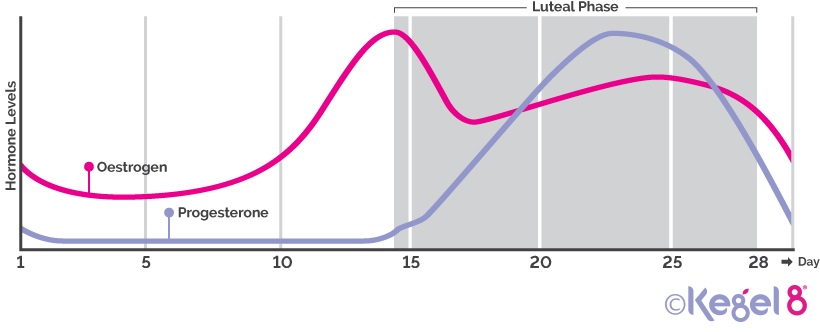
In the UK, the pelvic floor is not a topic taught in human biology classes. It is not discussed in great detail when we learn about the muscles of the body, and is not even given a mention when we learn about our periods.
But more research comes out all the time, and we now know just how connected the menstrual cycle and pelvic floor are.
The Menstrual Cycle
Your period is the result of your body getting ready for an embryo to be implanted, and it being upset when it doesn't happen (well... kinda).
Your menstrual cycle begins, on average, once every 28 days. Beginning on the first day of your period, and ending the day before your next period begins. The cycle is controlled by the hormones oestrogen and progesterone:
- Oestrogen develops and releases the eggs from your ovaries, in a process known as ovulation.
- Oestrogen thickens the uterus (womb) lining.
- Progesterone prepares the womb for an embryo.
- If a pregnancy does not occur, the egg is reabsorbed, the hormone levels fall, and the uterus lining sheds and leaves the body.
What Does My Period Have to Do with My Pelvic Floor?
The pelvic floor muscles are affected by the rise and fall of oestrogen throughout your menstrual cycle. During the luteal phase, the ~14 days between ovulation and the bleeding beginning, your muscles are at their strongest. When the oestrogen levels fall, at the end of your period, your muscles are at their weakest.
As a result of this, if you are suffering with a pelvic floor disorder, such as urinary incontinence, this will likely get worse towards the end of each period.

Can I Exercise My Pelvic Floor When I Am on My Period?
Yes! You may feel slightly delicate if you have heavy periods. But you still can, and should, exercise your pelvic floor throughout your period.
If you have a particularly heavy flow, the probe of your Kegel8 electronic toner may move and be less effective. If this is the case, or you do not want to use your probe during your period, you can use skin electrodes with your Kegel8 Ultra 20. These are placed on either the lower back or ankle, to stimulate the sacral and tibial nerves respectively. We are often told by customers, that the skin electrodes also help to relieve menstrual cramps when they are placed on the lower back.
Vitamin D and Your Period
Vitamin D deficiency is one of the most common deficiencies, affecting 1 in 5 people in the UK.
Being deficient in vitamin D can lead to poor musculoskeletal health, including a weak pelvic floor.
In women, vitamin D deficiency can also lead to irregular menstrual cycles as it is believed to play a part in ovulation, ovarian follicle development and preserving the ovarian reserve.
Therefore supplementing with vitamin D is essential to your pelvic health.
5 Fun Period Facts (If There Is Such a Thing)
- On average, a woman will have 480 periods in her life.
- During each period, you lose 3-5 tablespoons of blood.
- You are born with all your eggs - you don't grow new ones.
- After ovulation, the egg only lives for 24 hours.
- Sperm can survive in the fallopian tubes for up to a week after having sex.
Sources
[1] Micussi, M.T. et al. (2015) Is there a difference in the electromyographic activity of the pelvic floor muscles across the phrases of the menstrual cycle?][online]. Journal of Physical Therapy Science [viewed 11/08/2018]. Available from https://www.ncbi.nlm.nih.gov/pmc/articles/PMC4540855/
[2] National Health Service (2016) Periods of infertility in the menstrual cycle [online]. NHS [viewed 11/08/2018]. Available from https://www.nhs.uk/conditions/periods/fertility-in-the-menstrual-cycle/
[3] Vitamin D Council (2015) New study finds low vitamin D status linked to irregular menstrual cycles [online]. Vitamin D Council [viewed 11/08/2018]. Available from https://www.vitamindcouncil.org/new-study-finds-low-vitamin-d-status-linked-to-irregular-menstrual-cycles/
[4] British Nutrition Foundation (2018) New advice on Vitamin D [online]. British Nutrition Foundation [viewed 11/08/2018]. Available from https://www.nutrition.org.uk/nutritioninthenews/new-reports/983-newvitamind.html
[5] Dabrowski, F.A. et al. (2015) The Role of Vitamin D in Reproductive Health - A Trojan Horse or the Golden Fleece? [online]. Nutrients [viewed 11/08/2018]. Available from https://www.ncbi.nlm.nih.gov/pmc/articles/PMC4488777/





